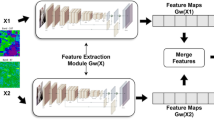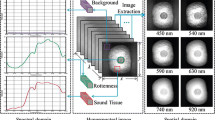Abstract
Classification is one of the forefront research areas in hyperspectral image processing. The large intra-class and small inter-class variance in the pixel values of objects of interest still poses challenges in classification task. The huge dimension and a minimal number of labeled information further add challenges in the case of hyperspectral image classification. Therefore, in the present research, a novel architecture is conceived which is inspired by the U-net architecture along with spectral partitioning. The proposed architecture (HyperUnet) mainly addresses the broader issue of classification of hyperspectral images by classifying each pixel. The performance of the proposed model is evaluated on two benchmark datasets and compared with existing U-net-based models. The overall classification accuracy obtained in experiments is more than 93% which is better than the other compared methods in the same field.






Similar content being viewed by others
References
Chang CI (2007) Hyperspectral data exploitation: theory and applications. Wiley
Miller DM, Kaminsky EJ, Rana S (1995) Neural network classification of remote-sensing data. Comput Geosci 21(3):377–386
Mas JF, Flores JJ (2008) The application of artificial neural networks to the analysis of remotely sensed data. Int J Remote Sens 29(3):617–663
Camps-Valls G, Bruzzone L (2005) Kernel-based methods for hyperspectral image classification. IEEE Trans Geosci Remote Sens 43(6):1351–1362
Mountrakis G, Im J, Ogole C (2011) Support vector machines in remote sensing: a review. ISPRS J Photogramm Remote Sens 66(3):247–259
Pal M (2005) Random forest classifier for remote sensing classification. Int J Remote Sens 26(1):217–222
Belgiu M, Drăguţ L (2016) Random forest in remote sensing: a review of applications and future directions. ISPRS J Photogramm Remote Sens 114:24–31
Guo R, Liu J, Li N, Liu S, Chen F, Cheng B, Duan J, Li X, Ma C (2018) Pixel-wise classification method for high resolution remote sensing imagery using deep neural networks. ISPRS Int J Geo Inf 7(3):110
Unar S, Wang X, Zhang C, Wang C (2019) Detected text-based image retrieval approach for textual images. IET Image Proc 13(3):515–521
Unar S, Wang X, Wang C, Wang M (2019) New strategy for CBIR by combining low-level visual features with a colour descriptor. IET Image Proc 13(7):1191–1200
Unar S, Wang X, Wang C, Wang Y (2019) A decisive content based image retrieval approach for feature fusion in visual and textual images. Knowl-Based Syst 179:8–20
Wang XY, Chen ZF (2009) A fast fractal coding in application of image retrieval. Fractals 17(04):441–450
Wang C, Wang X, Xia Z, Ma B, Shi YQ (2019) Image description with polar harmonic Fourier moments. IEEE Trans Circuits Syst Video Technol 30(12):4440–4452
Unar S, Wang X, Zhang C (2018) Visual and textual information fusion using Kernel method for content based image retrieval. Inf Fusion 44:176–187
Wang X, Wang Z (2013) A novel method for image retrieval based on structure elements descriptor. J Vis Commun Image Represent 24(1):63–74
Wang X, Wang Z (2014) The method for image retrieval based on multi-factors correlation utilizing block truncation coding. Pattern Recogn 47(10):3293–3303
Wang Xy, Chen Zf, Yun Jj (2012) An effective method for color image retrieval based on texture. Comput Standards Interfaces 34(1):31–35
Gu Y, Chanussot J, Jia X, Benediktsson JA (2017) Multiple kernel learning for hyperspectral image classification: a review. IEEE Trans Geosci Remote Sens 55(11):6547–6565
Zhang X, Cui J, Wang W, Lin C (2017) A study for texture feature extraction of high-resolution satellite images based on a direction measure and gray level co-occurrence matrix fusion algorithm. Sensors 17(7):1474
Gu Y, Liu T, Jia X, Benediktsson JA, Chanussot J (2016) Nonlinear multiple kernel learning with multiple-structure-element extended morphological profiles for hyperspectral image classification. IEEE Trans Geosci Remote Sens 54(6):3235–3247
Bharatkar PS, Patel R, Durbude DG (2014) Novel algorithm for RS image classification. J Indian Soc Remote Sens 42(2):435–437
Balakrishnan B, Darsana S, Mathews J, Nair MS (2018) Satellite/Aerial image compression using adaptive block truncation coding technique. J Indian Soc Remote Sens 46(11):1761–1771
Wang C, Wang X, Xia Z, Zhang C (2019) Ternary radial harmonic Fourier moments based robust stereo image zero-watermarking algorithm. Inf Sci 470:109–120
Kumar B, Dikshit O, Gupta A, Singh MK (2020) Feature extraction for hyperspectral image classification: a review. Int J Remote Sens 41(16):6248–6287
Chen Z, Hu Y, Zhang Y (2019) Effects of compression on remote sensing image classification based on fractal analysis. IEEE Trans Geosci Remote Sens 57(7):4577–4590
Beirami BA, Mokhtarzade M (2020) Spatial-spectral classification of hyperspectral images based on multiple fractal-based features. Geocarto Int. https://doi.org/10.1080/10106049.2020.1713232
Liu Y, Piramanayagam S, Monteiro ST, Saber E (2017) Dense semantic labeling of very-high-resolution aerial imagery and lidar with fully-convolutional neural networks and higher-order CRFs. In: Proceedings of the IEEE conference on computer vision and pattern recognition work-shops, pp 76–85
Noh H, Hong S, Han B (2015) Learning deconvolution network for semantic segmentation. In: Proceedings of the IEEE international conference on computer vision, pp 1520–1528
Wei X, Fu K, Gao X, Yan M, Sun X, Chen K, Sun H (2018) Semantic pixel labelling in remote sensing images using a deep convolutional encoder-decoder model. Remote Sens Lett 9(3):199–208
Simonyan K, Zisserman A (2014) Very deep convolutional networks for large-scale image recognition. arXiv preprint arXiv:14091556
He K, Zhang X, Ren S, Sun J (2016) Deep residual learning for image recognition. In: Proceedings of the IEEE conference on computer vision and pattern recognition, pp 770–778
Huang G, Liu Z, Van Der Maaten L, Weinberger KQ (2017) Densely connected convolutional networks. In: Proceedings of the IEEE conference on computer vision and pattern recognition, pp 4700–4708
Long J, Shelhamer E, Darrell T (2015) Fully convolutional networks for semantic segmentation. In: Proceedings of the IEEE conference on computer vision and pattern recognition, pp 3431–3440
Fu G, Liu C, Zhou R, Sun T, Zhang Q (2017) Classification for high resolution remote sensing imagery using a fully convolutional network. Remote Sens 9(5):498
Zhao H, Shi J, Qi X, Wang X, Jia J (2017) Pyramid scene parsing network. In: Proceedings of the IEEE conference on computer vision and pattern recognition, pp 2881–2890
Chen LC, Papandreou G, Kokkinos I, Murphy K, Yuille AL (2017) Deeplab: semantic image segmentation with deep convolutional nets, atrous convolution, and fully connected crfs. IEEE Trans Pattern Anal Mach Intell 40(4):834–848
Ronneberger O, Fischer P, Brox T (2015) U-net: Convolutional networks for biomedical image segmentation. In: International conference on medical image computing and computer-assisted intervention, Springer, pp 234–241
Chandra S, Kokkinos I (2016) Fast, exact and multi-scale inference for semantic image segmentation with deep gaussian crfs. In: European conference on computer vision, Springer, pp 402–418
Chandra S, Usunier N, Kokkinos I (2017) Dense and low-rank gaussian crfs using deep embeddings. In: Proceedings of the IEEE international conference on computer vision, pp 5103–5112
Yu F, Koltun V (2015) Multi-scale context aggregation by dilated convolutions. arXiv preprint arXiv:151107122
Ghiasi G, Fowlkes CC (2016) Laplacian pyramid reconstruction and refinement for semantic segmentation. In: European conference on computer vision, Springer, pp 519–534
Lin G, Milan A, Shen C, Reid I (2017) Refinenet: Multi-path refinement networks for high-resolution semantic segmentation. In: Proceedings of the IEEE conference on computer vision and pattern recognition, pp 1925–1934
Badrinarayanan V, Kendall A, Cipolla R (2017) Segnet: a deep convolutional encoder-decoder architecture for image segmentation. IEEE Trans Pattern Anal Mach Intell 39(12):2481–2495
Wang H, Wang Y, Zhang Q, Xiang S, Pan C (2017) Gated convolutional neural network for semantic segmentation in high-resolution images. Remote Sens 9(5):446
Chen LC, Zhu Y, Papandreou G, Schroff F, Adam H (2018) Encoder-decoder with atrous separable convolution for semantic image segmentation. In: Proceedings of the European conference on computer vision (ECCV), pp 801–818
Ghosh A, Ehrlich M, Shah S, Davis LS, Chellappa R (2018) Stacked U-Nets for ground material segmentation in remote sensing imagery. In: CVPR Workshops, pp 257–261
Chen LC, Yang Y, Wang J, Xu W, Yuille AL (2016) Attention to scale: Scale-aware semantic image segmentation. In: Proceedings of the IEEE conference on computer vision and pattern recognition, pp 3640–3649
Lin G, Shen C, Van Den Hengel A, Reid I (2016) Efficient piecewise training of deep structured models for semantic segmentation. In: Proceedings of the IEEE conference on computer vision and pattern recognition, pp 3194–3203
Lguensat R, Sun M, Fablet R, Tandeo P, Mason E, Chen G (2018) EddyNet: A deep neural network for pixel-wise classification of oceanic eddies. In: IGARSS 2018-2018 IEEE international geoscience and remote sensing symposium, IEEE, pp 1764–1767
Li R, Liu W, Yang L, Sun S, Hu W, Zhang F, Li W (2018) Deepunet: a deep fully convolutional network for pixel-level sea-land segmentation. IEEE Jof Sel Top Appl Earth Obs Remote Sens 11(11):3954–3962
Signoroni A, Savardi M, Baronio A, Benini S (2019) Deep learning meets hyperspectral image analysis: a multidisciplinary review. J Imaging 5(5):52
Makantasis K, Karantzalos K, Doulamis A, Doulamis N (2015) Deep supervised learning for hyperspectral data classification through convolutional neural networks. In: 2015 IEEE international geoscience and remote sensing symposium (IGARSS), IEEE, pp 4959–4962
Paul A, Chaki N (2021) Dimensionality reduction using band correlation and variance measure from discrete wavelet transformed hyperspectral imagery. Ann Data Sci 8(2):261–274
Paul A, Chaki N (2020) Supervised data driven approach for hyperspectral band selection using quantization. Geocarto Int. https://doi.org/10.1080/10106049.2020.1822929
Paul A, Sahoo P, Chaki N (2020) Dimensionality reduction of hyperspectral images: a data-driven approach for band selection. In: Advanced computing and systems for security, Springer, pp 11–27
Paul A, Chaki N (2020) Dimensionality reduction of hyperspectral image using signal entropy and spatial information in genetic algorithm with discrete wavelet transformation. Evolut Intell. https://doi.org/10.1007/s12065-020-00460-2
Paul A, Chaki N (2019) Dimensionality reduction of hyperspectral images using pooling. Pattern Recognit Image Anal 29(1):72–78
Paul A, Bhattacharya S, Dutta D, Sharma JR, Dadhwal VK (2015) Band selection in hyperspectral imagery using spatial cluster mean and genetic algorithms. GISci Remote Sens 52(6):643–659
Li J, Bioucas-Dias JM, Plaza A (2011) Spectral-spatial hyperspectral image segmentation using subspace multinomial logistic regression and Markov random fields. IEEE Trans Geosci Remote Sens 50(3):809–823
Liu Y, Li J, Plaza A, Bioucas-Dias J, Cuartero A, Rodríguez PG (2014) Spectral partitioning for hyperspectral remote sensing image classification. In: 2014 IEEE geoscience and remote sensing symposium, IEEE, pp 3434–3437
Chu RS, Ng HC, Wang X, Luk W (2019) Convolution based spectral partitioning architecture for hyperspectral image classification. In: IGARSS 2019-2019 IEEE international geoscience and remote sensing symposium, IEEE, pp 3962–3965
Paul A, Bhoumik S, Chaki N (2021) SSNET: an improved deep hybrid network for hyperspectral image classification. Neural Comput Appl 33(5):1575–1585
Li R, Zheng S, Duan C, Yang Y, Wang X (2020) Classification of hyperspectral image based on double-branch dual-attention mechanism network. Remote Sens 12(3):582
Chollet F (2017) Xception: deep learning with depthwise separable convolutions. In: Proceedings of the IEEE conference on computer vision and pattern recognition, pp 1251–1258
Liu Y, Li J, Du P, Plaza A, Jia X, Zhang X (2016) Class-oriented spectral partitioning for remotely sensed hyperspectral image classification. IEEE J Sel Top Appl Earth Observ Remote Sens 10(2):691–711
Paul A, Chowdary V, Srivastava Y, Dutta D, Sharma J (2017) Change detection of linear features in temporally spaced remotely sensed images using edge-based grid analysis. Geocarto Int 32(6):640–654
Paul A, Tripathi D, Dutta D (2018) Application and comparison of advanced supervised classifiers in extraction of water bodies from remote sensing images. Sustain Water Resour Manag 4(4):905–919
Acknowledgements
The authors acknowledge the support of CGM RCs, NRSC, ISRO, GM, RRSC-East, NRSC and Head (Applications), RRSC-East, NRSC, for carrying out the work. The authors also acknowledge the collaboration extended by VC, MAKAUT, toward the work.
Author information
Authors and Affiliations
Corresponding author
Ethics declarations
Conflict of interest
The authors declare that there is no conflict of interest.
Additional information
Publisher's Note
Springer Nature remains neutral with regard to jurisdictional claims in published maps and institutional affiliations.
Rights and permissions
About this article
Cite this article
Paul, A., Bhoumik, S. Classification of hyperspectral imagery using spectrally partitioned HyperUnet. Neural Comput & Applic 34, 2073–2082 (2022). https://doi.org/10.1007/s00521-021-06532-3
Received:
Accepted:
Published:
Issue Date:
DOI: https://doi.org/10.1007/s00521-021-06532-3




